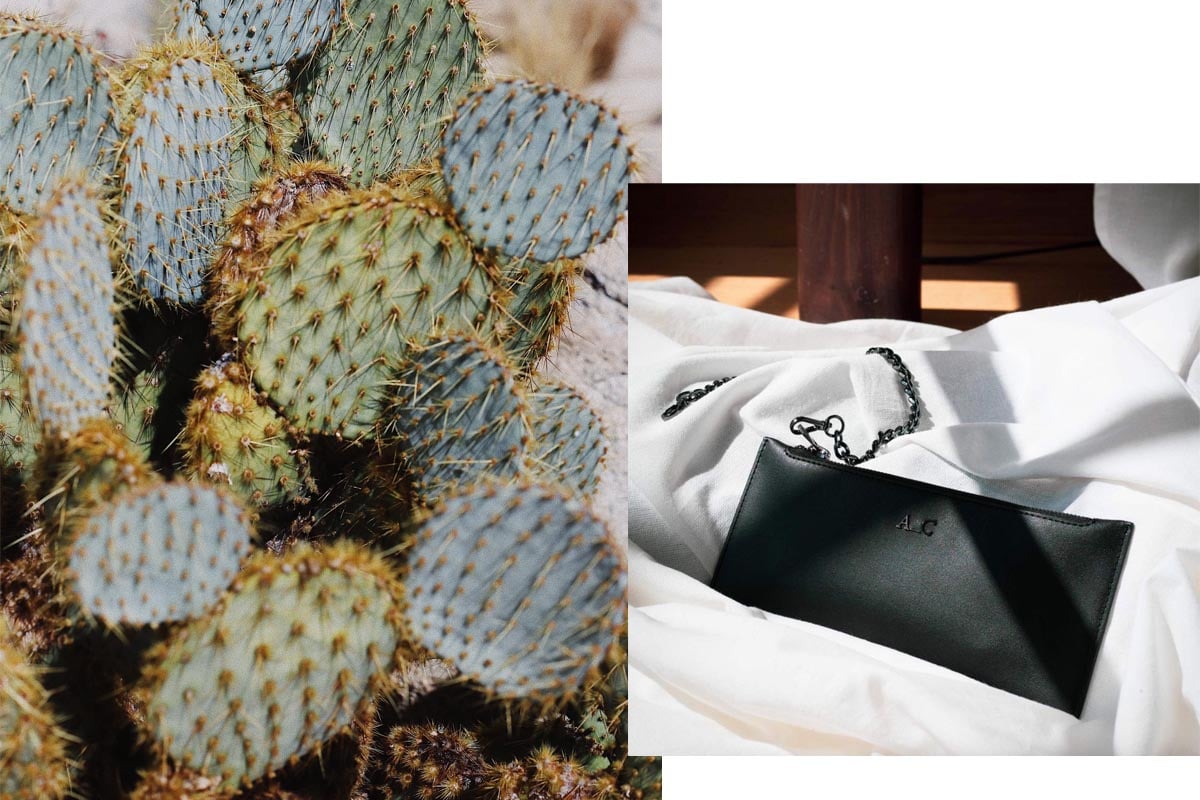
By now, most of us know that the impact cattle and livestock has on the environment is big. So cow leather can feel like an unsustainable choice. But given that the alternative to leather suspiciously dubbed "vegan leather" is literally just plastic, cow leather still wins out on longevity and waste-reduction.
But what to do if you don't want to weather animal leather or contribute to the creation of virgin plastic? Allow us to introduce you cactus leather. Like mushroom leather, this is a new leather alternative that offers a similar longevity to animal leather but without the plastics associated with tradition "vegan leather". To good to be true? Apparently not.
We spoke to Tessa Carroll, founder & creative director, AC Official - a brand created using cactus leather. Below, she explains everything you need to know about cactus leather.
Can you explain what is cactus leather? How do you make leather out of a cactus?
I work with the innovators of Desserto, a cactus-based biomaterial that is an alternative to animal leather. It is made by harvesting the mature leaves of a prickly pear cactus and extracting proteins and fibres to make an organic bio resin which then is coated on a carrier.
What cacti can you make leather out of?
Its fancy scientific name is Opuntia Ficus Indica but we know it commonly as Prickly Pear or Nopal.
Cactus leather is being heralded as a much more sustainable option than other vegan leathers? Why is this?
This is for many reasons, such as the fact that cacti fields are a huge carbon sink which means the growing process alone is a great help when sequestering carbon from the atmosphere. Also, a well-known fact about cacti is they don’t require very much water to thrive. This means the water savings in their growth and harvest are exponentially lower to that of waxed cotton for example. In fact, Desserto do not have irrigation programs in place on the ranch. The cacti are fostered with rainwater only and organically grown meaning no herbicides or pesticides are used in the process. Additionally, when the cactus is fully grown (this takes 6-8 weeks at most) the most mature leaves are removed from the plant, leaving the root system in the ground and therefore not disturbing the soil which would otherwise release carbon if pulled out. Working with Desserto has been an incredible journey as they consider every step of the value chain to ensure sustainability. From land resource and management, all the way through to the actual material.
How does it compare to animal leather in terms of sustainability?
In layman’s terms, leather, whether the by-product of the meat industry or not, is not a natural product by the time it reaches the consumers hands. From the immense amount of toxic chemicals required to stop it from rotting when we carry it, to the water required to grow the grass used to feed the livestock in the first place, leather is one of the most resource intensive processes available. It is believed to require 17,000 litres of fresh drinking water to make 1kg of leather. Additionally, EPAs (Environmental Protection Agencies) deem previous leather tannery sites as defunct for a certain period after their use, much like a petrol station, due to the levels of toxic chemicals in the soil. And finally, once leather reaches landfill again, it leeches these toxins into our soils, rendering them infertile and reducing our ability to grow anything in them until they are regenerated.
Does cactus leather last and have a similar longevity to animal leather?
One of great things about leather is that it lasts forever…. But this is part of the problem too. Things that last forever are always going to need a place on this earth whether it is in your wardrobe, the charity store or simply dumped into landfill. Desserto® offers a wide variety of materials with different technical performance, but overall, they can completely substitute leather without sacrificing quality and with the right designer - without compromising style.
Does cactus leather biodegrade?
Desserto offers different levels of sustainable materials, its most sophisticated version delivers up to 92% organic carbon content from plants which makes the material highly biodegradable. It is backed with a range of different textiles, depending on the purpose of the textile. At A_C Official, we opt for 100% organic cotton backing but there are also recycled cotton recycled polyester backing fabrics as well as a rubber option for furnishings.
Do you think this is a better option?
Absolutely. It is 2021 and we’re running out of time to turn this world around. By working with innovative plant-based materials, we can significantly reduce the environmental impacts of the fashion industry whilst protecting workers in the supply chain and opening the conversation as to Who Made My Handbag and What Is My Handbag Made of? Transparency, visibility and sustainability. What do you think more people should know about the leather industry? Cattle ranching is the largest driver of Amazon deforestation with 20% of the Amazon already destroyed. We lose an area the size of the UK to this every year.
The leather industry uses toxic chemicals like pesticides, chromium salts, tanning liquor, sulphide, acidic effluents and many more noxious substances harming people and environment. It generates incredible amounts of waste from the tanning process through to manufacturing and currently around 80% of leather worldwide is tanned using chrome which is evident in the health of the workers who breathe this in daily. Not to mention the life of the animal it requires for its existence. Sadly, even in fully modernised tanneries it is nearly impossible to reclaim all the pollutants generated by the tanning processing. Vegetable tanned leather is a nice idea but it does not take out the natural resources required to grow and harvest the livestock in the first place. If we are so concerned with the amount of energy required to make a hamburger, shouldn’t we be concerned about the amount that goes into the making of our wallet?
Image: Taylor Simpson on Unsplash



